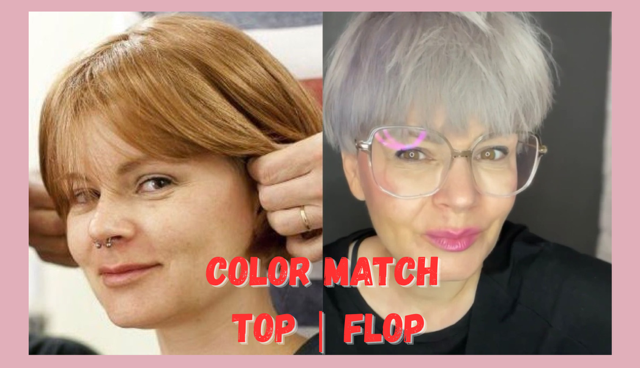When Your Hair Screams and Your Skin Cries:
How Grey Blending Brings Balance Back to Your Reflection
Sometimes, a single photo tells the whole story.
On the left: a typical shade built up over years. The skin looks tired, the hair dominant, orange, yellowish, somehow… loud and unbalanced.
On the right: the same woman. Brighter, clearer, more harmonious. Her complexion glows, her hair shines soft and silvery, as if it had always grown that way.
What lies in between? No radical cut. No filter. Just a conscious decision to step away from the dyeing stress and into a concept that works with you, not against you: Grey Blending.
FUN FACT: That’s me, and yes, there are a few years (and a wig in the before picture) in between 😉
☝️ Why All These Warm Tones in the First Place?
If you’ve been coloring or tinting your hair for years, especially with darker shades, here’s what happens:
The color pigments build up in layers. Especially with browns and reds, many warm undertones stay in the hair permanently (this is called the “underlying pigment”), even when the surface color has long faded.
When the hair grows out or is lightened, these tones suddenly become visible:
• Orange tint: often comes from old red pigments
• Yellow tint: typical “shine-through” of lightened natural pigments
• Dullness or patchy transitions: if the hair structure is unevenly porous
And here’s the thing: most people don’t naturally have warm hair tones. That means these shades rarely match your skin tone, they can make you look dull, tired, or “over-dyed.”
🎯 What Can You Do About Yellow and Orange Tints?
First: Understand how color works. The right hair color consultation is essential.
Warm tones don’t appear “by accident”, they show up when pigments aren’t neutralized or are placed incorrectly.
If you want to go grey, stylishly, modern, and without granny vibes—you need a targeted strategy. For example:
• Glossings & toning: These act like a cool veil over overly warm tones, giving a silvery clarity, without bringing out the warmth underneath.
• Balayage or babylights: These techniques create softness and movement instead of harsh color blocks
• Color correction for old pigments: If there’s too much old dye in the hair, you’ll need to “clean up” before rebuilding anew
Sound technical? It is. But that’s exactly what color experts are for, so you don’t have to struggle through YouTube tutorials, but instead get the result you’ve always wanted.
💡 A True Game Changer: Color That Supports You
A good hair color should highlight your skin, not work against it.
If you suddenly find yourself needing makeup tricks just to make your hair “work,” something’s off.
Silvery, cool shades often bring a calmness and clarity to your look that was hidden under all that dye.
The result?
More radiance in your face.
More contrast, without harshness.
More you, less “just color on your head.”
🙋♀️ The Classic Story: From Color Frustration to Color Joy
Most of my grey blending clients don’t come out of curiosity, they come out of frustration:
“I just don’t look fresh anymore, even though I color all the time.”
“These yellow-orange tones are driving me crazy.”
“I don’t want to run to the salon every three weeks.”
And then, one day, comes the key moment:
You look in the mirror and ask:
Why am I doing this to myself?
The transformation usually starts quietly, with a consultation, a plan.
Not a big makeover, but a mindful rebuild.
The dye fades, your personality returns. Your eyes light up again.
And your skin? Finally breathes.
🧴 Care Tip for Long-Lasting Cool Shine
You’ve reached your goal, but now you want to keep it.
Here are my three essentials for maintaining your hair color in everyday life:
- Purple shampoo with anti-yellow effect (max. 2x/week or it’ll turn purple)
- Glossing every 6–8 weeks for extra radiance
- Heat protection & UV filter to prevent new yellow tones
Small steps, big impact, so your look stays beautiful not just today, but long term.
Facts
Are cool tones high-maintenance? YES, because they’re very fleeting.
Do we need a well-thought-out plan for the transition? YES.
Does it get easier over time? YES.
Grey Blending isn’t a technique. It’s a mindset shift.
A conscious move away from artificial, unsuitable colors, towards something that truly fits you.
If your hair is draining you instead of supporting you, it’s time for a change.
And if you’ve already reached your “after” photo, you know exactly what I mean.
If you want to take this journey, with a plan, experience, and someone who truly listens, let’s talk.
I’m Anja, Grey Blending Expert at dein Friseur Berlin Mitte.
And I know what real transformation should feel like: clear, soft, harmonious.
Book your consultation now.

